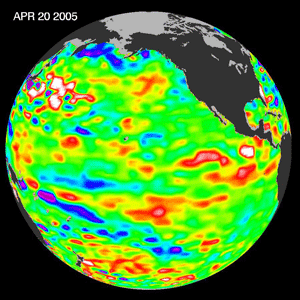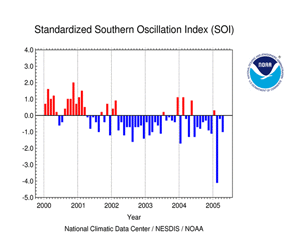SST ANOMALIES INCREASE IN THE EASTERN PACIFIC
|
|
Sea-Surface
Temperatures (SSTs) and
Mixed-Layer Conditions: SSTs increased across the eastern equatorial Pacific Ocean and along the South American coast in April (note the observed increase in SSTs in the Niño 1+2 region), although the monthly averaged SST anomaly increased only slightly in the central parts of the Pacific basin. In the mixed-layer, above average temperature anomalies moved eastward during the month into the eastern equatorial Pacific, with the largest anomalies reaching over 3°C at 50 m depth between 120°W and the South American coast. The depth of the 20°C isotherm increased in April as well, with the largest depth anomalies in the eastern equatorial Pacific. For the month, the SST anomaly in the Niño 3.4 Index region in the central equatorial Pacific Ocean increased slightly to +0.36°C (+0.65°F) above the mean. In the western Pacific region, the SST anomaly decreased in April, with a monthly averaged Niño 4 Index value of +0.51°C (+0.92°F) (map of Niño regions). For the most recent ocean surface temperature conditions, please see the loop of satellite-derived weekly SST anomalies for April 2005. Above average SST anomalies persisted throughout the latter-half of 2004 and into early 2005 in the western and central equatorial Pacific basin, which can be seen in the data from NCDC's Extended Reconstructed Sea Surface Temperature dataset (ERSST version 2). Despite the slight increase in the monthly averaged SSTs in the central equatorial Pacific this past month, the 3-month running mean of the Niño 3.4 Index remained below +0.5°C in April. (NOTE: A running 3-month mean SST anomaly above +0.5°C in the Niño 3.4 region is one indicator that an El Niño is occurring. For the official NOAA classification scheme, please see NOAA's El Niño/La Niña Index Definition and see the CPC ENSO Diagnostic Discussion for NOAA's latest official assessment of ENSO conditions.) |
|
|
Equatorial
Zonal Winds (U-Component Winds) and Sea-Level
Topography: The trade winds were near- to above-normal across much of the eastern and central equatorial Pacific basin during April. In the western parts of the basin near the date line, westerly wind anomalies at the beginning of April dissipated as easterly trade winds increased during the latter half of the month (see the April zonal wind loop). Several high frequency fluctuations in the trade winds also occurred in the central tropical Pacific during April, as the strength of the easterly flow varied considerably along the equatorial zone. Satellite altimetry of ocean surface topography from the NASA/JPL Jason-1 satellite over the Pacific basin and global oceans is shown to the left. The April 20th overpass of the Jason-1 satellite shows that another Kelvin wave had developed and was propagating across the equatorial Pacific basin and into the central equatorial Pacific near the end of the month. |
|
|
Outgoing
Longwave Radiation (OLR): The map to the left shows the spatial pattern of global OLR (in W m-2) observed by satellite during April. Negative OLR anomalies were measured west of the date line in the western tropical Pacific and along the South Pacific Convergence Zone (SPCZ) during the past month. In addition, negative OLR anomalies were observed just north of the equator in the central and eastern Pacific, while in contrast positive OLR anomalies were observed immediately south of the equator in the central and eastern portions of the Pacific basin. Note that the enhanced tropical convection that occurred in February associated with the formation of numerous tropical cyclones is still reflected in the most recent 3-month averaged OLR anomalies, with large areas of negative OLR anomalies near the dateline and westward along the equator, as well as along the SPCZ. The monthly-averaged OLR Index shifted sign to a negative value in April, with an index of -0.4 averaged across an area centered over the date line in the western Pacific (between 160° E and 160° W). The recent shifts in sign of the OLR Index reflected the lack of persistence of El Niño conditions in the atmosphere since it developed in mid-2004. Note that high frequency variability in OLR is typically associated with the Madden-Julian Oscillation (MJO) (MJO related convective activity propagates west to east in the near-equatorial region from the Indian Ocean into the Pacific Ocean approximately every 30-60 days). The latest MJO activity can be seen in CPC's graphs of Daily MJO Indices. |
| Southern
Oscillation Index (SOI): The standardized SOI decreased in April, with a monthly averaged value of -1.0 (note that negative SOI values are consistent with El Niño conditions). This transition to a lower SOI value in the atmosphere followed the near-neutral SOI in March and the unusually low index in February. The SOI has shown some unusual behavior during the relatively weak 2004-2005 El Niño event. For example, during the latter-half of 2004 the monthly SOI fluctuated several times between a near-neutral value and a more negative index associated with warm event conditions (although 2004 ended with seven consecutive negative monthly values). In summary, the SST anomalies and atmospheric indices suggest that the current ENSO warm event remained weak, despite the recently observed warming of the SST anomalies in the Niño 1+2 region during April. |
Additional Links
- ENSO Monitoring
- NOAA El Niño / La Niña Index Definition
- NOAA's Pacific Marine Environmental Laboratory (PMEL):
- NOAA's Climate Prediction Center (CPC):
- NOAA's Physical Science Laboratory
- NASA/JPL Ocean Surface Topography from Space
- Australian Bureau of Meteorology (BoM) Climate Driver Update
- IRI - International Research Institute
 NOAA's National Centers for Environmental Information
NOAA's National Centers for Environmental Information







